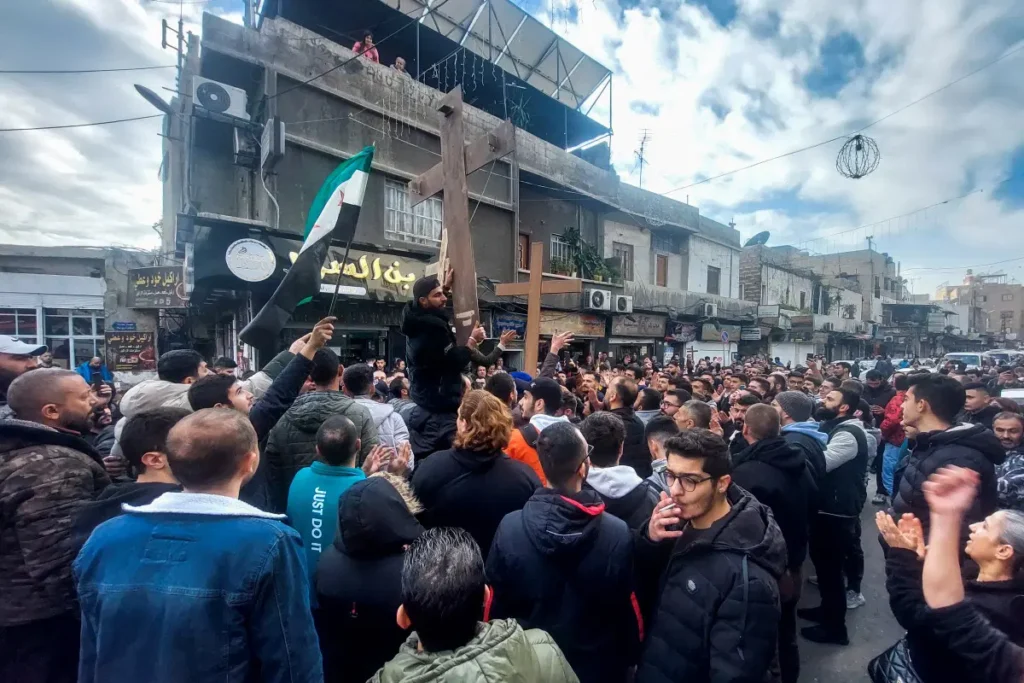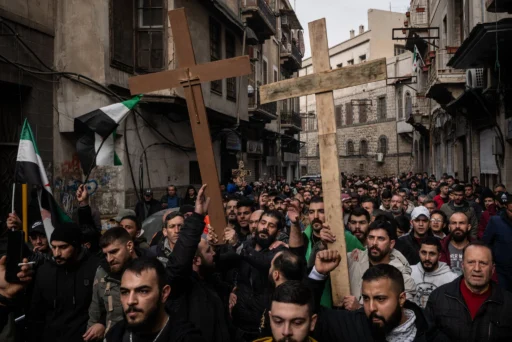Protests in Syria
Introduction
Protests in Syria: In a nation often marked by its rich cultural tapestry and tumultuous history, recent events in Syria have sparked global concern. The burning of Christmas trees—a symbol of peace and festivity—has led to widespread protests, reflecting deep-seated cultural, religious, and political tensions. This article explores the incident, its implications, and the broader socio-political dynamics at play.
Historical Context of Religious and Cultural Tensions in Syria
Overview of Syria’s Religious Diversity
Syria is home to a variety of religious communities, including Sunni Muslims, Christians, Alawites, Druze, and Kurds. While these groups have coexisted for centuries, historical and political challenges have often fueled divisions.
Historical Precedents of Religious and Cultural Clashes
Protests in Syria: Religious tensions in Syria are not new. Incidents of cultural misunderstanding and political exploitation of religious identities have occasionally escalated into conflict. Understanding this history is crucial to contextualizing the current protests.

The Incident: Christmas Tree Burning: Protests in Syria
What Happened?
Protests in Syria
The protests were triggered by the burning of Christmas trees in public spaces, an act seen by many as a direct attack on the Christian community in Syria. The incidents reportedly occurred in multiple regions, including urban centers and rural areas.
Locations Affected by the Protests
Major cities such as Damascus and Aleppo witnessed significant demonstrations, with smaller protests occurring in other parts of the country. These areas are home to diverse populations, making the incidents particularly sensitive.
Immediate Reactions from Local Communities
The Christian community expressed outrage, while many Muslim leaders condemned the act, calling for unity and mutual respect. Social media platforms became a battleground for debates, amplifying the issue internationally.
Social and Political Implications
How Religious Symbols Are Politicized
Religious symbols like the Christmas tree often become tools for political agendas. In this case, the act of burning the trees was interpreted as an attempt to deepen sectarian divides.
Role of the Government in Managing Religious and Cultural Issues
The Syrian government’s response has been criticized for being slow and inadequate. While officials have condemned the incidents, their actions have not addressed the underlying causes of such tensions.
International Response and Media Coverage
The international community, including religious organizations and human rights groups, has condemned the incidents. Media outlets worldwide have highlighted the protests, drawing attention to Syria’s ongoing struggles with religious and cultural coexistence.

Perspectives from Different Communities
Voices of the Christian Community
Christian leaders have called for justice and emphasized the need for protecting minority rights in Syria. Many have expressed fear over the rising intolerance symbolized by these acts.
Perspectives from Muslim Leaders
Prominent Muslim clerics have condemned the incidents, emphasizing that such actions do not represent Islamic values. They have called for solidarity and interfaith dialogue.
Role of Secular Groups in Addressing the Conflict
Secular organizations in Syria have advocated for education and awareness campaigns to promote tolerance and understanding among different communities.
Protests and Their Development
Timeline of the Protests
- Day 1: Christmas tree burning incidents reported.
- Day 2-3: Outrage spreads across social media; protests begin in major cities.
- Week 1: International media coverage intensifies; government issues a statement.
Key Leaders and Movements
The protests have been led by a mix of religious leaders, activists, and community organizations advocating for justice and tolerance.
Methods of Protest: Peaceful and Otherwise
While most demonstrations have been peaceful, isolated incidents of violence and vandalism have been reported, further complicating the situation.

Economic and Cultural Impact
Impact on Local Businesses
Businesses, particularly those owned by Christians, have faced economic losses due to vandalism and decreased consumer confidence.
Effects on Inter-Community Relations
The incidents have strained relationships between religious communities, threatening the fragile coexistence in Syria.
Long-Term Implications for Cultural Heritage
The burning of Christmas trees has raised concerns about the preservation of Syria’s multicultural identity and heritage.

Lessons and Path Forward
Building Bridges Between Communities
Promoting interfaith dialogue and understanding is essential to prevent such incidents in the future. Community leaders must work together to rebuild trust.
Role of Education in Promoting Religious Tolerance
Education programs that emphasize respect for cultural and religious diversity can play a crucial role in fostering long-term harmony.
Recommendations for Government Policy
The government must take proactive measures to address religious and cultural tensions, including stricter enforcement of anti-discrimination laws and support for minority communities.
FAQs about Protests in Syria over Christmas Tree Burning
Why did the Christmas tree burning lead to protests in Syria?
The burning of Christmas trees was seen as a direct attack on the Christian community, sparking outrage and protests across the country.
What is the historical significance of Christmas trees in Syria?
While not native to Syria, Christmas trees have become a symbol of festivity and religious celebration for the Christian community.
How has the Syrian government responded to these protests?
The government has condemned the incidents but has been criticized for not addressing the root causes of religious and cultural tensions.
Are these protests indicative of larger cultural or political issues?
Yes, the protests highlight deeper issues of sectarianism and the politicization of religious symbols in Syria.
How have international organizations reacted to the incident?
International organizations have condemned the incidents and called for measures to protect religious minorities in Syria.
What can be done to prevent such incidents in the future?
Promoting interfaith dialogue, enforcing anti-discrimination laws, and educating communities about tolerance are crucial steps to prevent similar incidents.
Source : BBC




